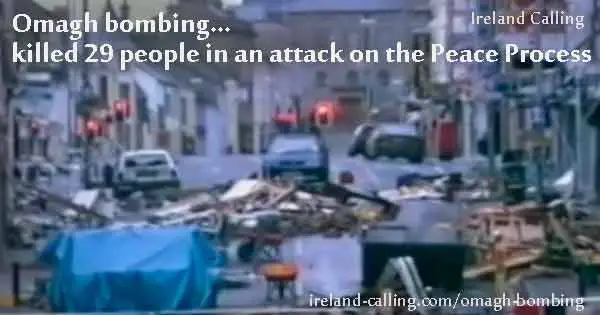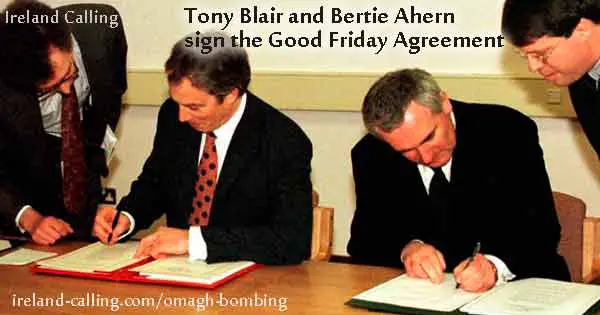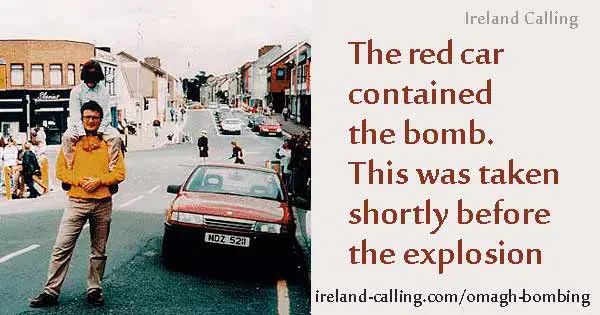The Omagh bombing was the single most devastating attack in the history of the Troubles in Northern Ireland. It happened on 15 August, 1998 when dissident Republicans planted a huge car bomb in a crowded shopping area in the centre of Omagh.
The explosion killed 29 people as well as two unborn babies in their mother’s womb. Another 220 people were badly injured.

As well as feeling outrage at the atrocity itself, people throughout Ireland and the UK were shocked and angry that it should come at a time when the Peace Process was taking huge steps and it seemed at last that Northern Ireland might have a better future.
The previous year, 1997, the IRA had declared a ceasefire as part of the ongoing negotiations towards ending violence and finding a political settlement that would be acceptable to both the Nationalist and Loyalist communities, and the Irish and the British governments.
Those negotiations had led to the signing of the Good Friday Agreement in 1998, which paved the way for a power sharing assembly in Northern Ireland. A referendum on the Agreement had taken place, with 71% of people in the North voting in favour.

Elections to a new Northern Ireland Assembly took place in June and a new power sharing executive was due to be appointed the following year.
Meanwhile, dissident Republicans were intent on derailing the Peace Process. Not everyone in the IRA had been in favour of the ceasefire. Some hardliners broke away in October 1997 and formed what they called the Real IRA with the intention of carrying on the armed struggle.
They carried out a number of attacks in 1998 but the Omagh bombing was by far the most devastating. A 500lb bomb was placed in a car parked in the town centre. It exploded at 3.10 when the area was crowded with shoppers.
Confusion meant people were herded towards the explosion
The death count was made worse because the bombers had given confusing information about the location of the car in a warning telephone call shorty before the bomb went off. It meant that police trying to evacuate the area ended up herding people towards the explosion rather than away from it.
The 29 victims were all innocent civilians and included nine children. They came from both sides of the community, Protestant and Catholic. A pregnant woman and her unborn twins were also killed, along with two visitors from Spain.
A Spanish tourist posed for a photograph with a child on his shoulder close to the red car that was used in the explosion. They survived but the photographer was killed.

The explosion burst a water main and send a rush of water along the side of the street. An eyewitness described how the running water picked up human body parts and carried them along.
She said: “There were people, or actually pieces of people, bodies being washed in… they were basically piling up at the corner where the gully was… bits and pieces of legs, arms, whatever, were floating down the street.”
A bus driver ferried some of the injured to hospital. He later described the journey: “It was like a scene from hell. I wasn’t able to drive fast because people were screaming in pain. As we went over the ramps into the hospital, I could hear the roars of pain.”
Another eyewitness said: “There were limbs hanging off, bodies being carried on doors, everything was chaotic. Then just as the bus was about to leave, the door opened and someone handed in a severed arm. I think that was just too much for the driver. I think he cried all the way to the hospital.”
There was wave of grief throughout the whole of Ireland and a sense of fury at the bombers who were continuing their campaign against the wishes of the people who had overwhelmingly endorsed the Peace Process in the referendum a few months earlier.
The Omagh parish priest Father Thomas Canning said: “I really don’t know how the town of Omagh is ever going to come to terms with this awful catastrophe.”
For a while, everyone held their breath fearing that the Good Friday Agreement and the move towards peace might fail, with a return to sectarian violence. Instead, the bomb seemed to galvanise everyone to work even harder.
Bombing condemned by Gerry Adams and Martin McGuiness
Sinn Féin president Gerry Adams urged the dissidents to give peace a chance and condemned the bombing, saying: “I am totally horrified by this action. I condemn it without any equivocation whatsoever.”
Martin McGuinness, who was Sinn Féin’s chief negotiator in the Peace Process, said: “This appalling act was carried out by those opposed to the peace process”.
The Omagh bombing meant that the IRA came under added pressure to decommission its weapons, but the negotiations remained on track. The public outrage seemed to get through to the dissidents who issued an apology and then announced a ceasefire, although they did return to violence again later.
A few weeks after the bombing, US President Bill Clinton and British Prime Minister Tony Blair arrived in Omagh to meet the 700 people who were injured the families of those who had died. Clinton had devoted a great deal of his presidency to the Peace Process and Blair was similarly committed to finding a lasting, political solution.
Within a month of Omagh it was clear that the bombers had failed in their attempts to derail the peace negotiations when Unionist leader David Trimble and Sinn Féin President Gerry Adams met for direct talks the first time.
It wasn’t necessarily a cordial meeting, they pointedly did not shake hands, but at least they were talking and peace campaigners breathed a sigh of relief.
Aftermath of Omagh bombing steeped in controversy
The aftermath of the Omagh bombing sparked a series of controversies. There were allegations that the security forces in Ireland, Britain and the United States had intelligence that could have prevented the bombing but they failed to hand it over to the police.
The Police Ombudsman Nuala O’Loan held an inquiry into the RUC’s handling of the Omagh bombing. Her report criticised them for failing to act on crucial intelligence and said they had ignored previous warnings about a bomb.
The report said: “The victims, their families, the people of Omagh and officers of the RUC were let down by defective leadership, poor judgement and a lack of urgency.”
The Chief Constable of the RUC, Ronnie Flanagan, was furious with the findings and called the report “grossly unfair”. He described it as “an erroneous conclusion reached in advance and then a desperate attempt to find anything that might happen to fit in with that”.
British Prime Minister Tony Blair and Irish Taoiseach Bertie Ahern agreed to cooperate to bring the bombers to justice but there have been no successful convictions.
Twelve men were arrested on 22 September 1998 by the Guardai and the RUC but they were later released without charge. A conviction against another alleged bomber was quashed on appeal.
On 15 March 2000, the families of the 29 Omagh victims began a civil case against five men named in a BBC Panorama Television programme as being responsible for the bombing. On 8 June, 2009, they were awarded £1.6m damages against four of the men.
The fifth man was cleared of involvement. None of the money has so far been paid to the families.
More history articles
The Neolithics – first people to leave their mark on Ireland